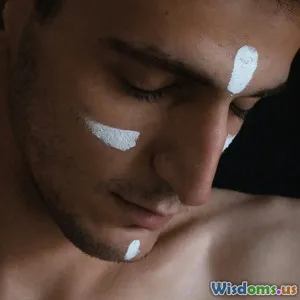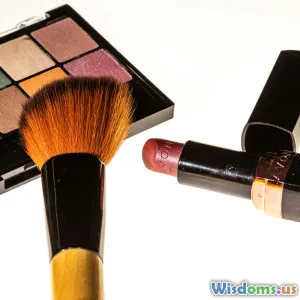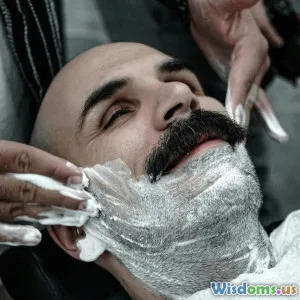
Do Facial Rollers Actually Reduce Puffiness or Is It Hype
19 min read Explore if facial rollers truly reduce puffiness or if it’s beauty hype, with expert opinions, scientific insights, and skincare tips. (0 Reviews)
Do Facial Rollers Actually Reduce Puffiness or Is It Hype?
There’s a serene satisfaction in rolling a cool jade stone across your cheekbones—social media is captivated, beauty influencers claim life-changing results, and even celebrities include facial rollers in their daily regimens. But as claims swirl about these crystal-tipped tools and their apparent magic, an important question remains: do facial rollers genuinely reduce puffiness, or are they simply an Instagram-driven trend without real science backing them?
In this article, we dig deep into the allure and the evidence behind facial rollers, separate science from speculation, and help you determine if these tools deserve a spot in your skincare routine.
What Are Facial Rollers? A Look Beneath the Surface

Facial rollers are handheld tools, typically made from jade, rose quartz, or stainless steel, designed for massaging the face in gentle, rolling motions. The two-ended design generally includes a larger roller for broad areas like the cheeks and forehead, and a smaller roller for more delicate zones like under the eyes.
The use of stones in self-care actually dates back centuries. For example, jade rolling can be traced to the Chinese elite as far back as the 7th century, where it symbolized prosperity and was thought to possess healing powers. Modern facial rollers burst onto the Western beauty scene in the last decade, heavily promoted for their ability to boost circulation, reduce puffiness, and even sculpt facial contours.
The Promise: How Facial Rollers Claim to Reduce Puffiness

Beauty brands and advocates tout facial rollers as mini-miracles for combating puffiness. The theory is simple: rolling motions, especially with a cold stone, stimulate lymphatic flow. Lymph fluid, which collects waste and toxins, can sometimes pool beneath the skin—especially after sleeping or consuming salty foods—causing swelling. By encouraging drainage toward the lymph nodes, rollers are believed to help move excess fluid, leading to a slimmer, less puffy appearance.
Many also claim that facial rollers boost microcirculation in the skin, giving the complexion a temporary glow. Cold rollers (often stored in the fridge) may constrict blood vessels, further shrinking puffiness. Some users notice that under-eye bags look less pronounced after a quick morning massage.
Anecdotal before-and-after stories abound online: beauty bloggers unboxing their jade rollers and enthusiastically demonstrating their de-puffing powers. But what does clinical research reveal?
The Science: Evidence for (and Against) Facial Rollers

A thorough look at peer-reviewed studies reveals a nuanced picture. While direct research on facial rollers is limited, the theoretical basis comes from the broad body of knowledge about lymphatic massage and cold therapy in skincare.
Lymphatic Drainage: Fact or Marketing Fantasy?
Lymphatic drainage is a real physiological process whereby the lymphatic system clears toxins and manages fluid levels. Manual lymphatic drainage, a technique employed by aestheticians and physical therapists, has proven benefits for managing swelling (edema) after certain medical procedures. However, the pressure required is precise and often more targeted than a home roller provides.
A small 2018 study published in the Journal of Cosmetic Dermatology reported improved blood flow in faces after 5 minutes of gentle massage (rolling included as a technique), but didn’t provide definitive evidence that facial rollers cause sustained de-puffing. Dermatologists note that while massage can temporarily shift some fluid, there is limited evidence to suggest the effect lasts for many hours or days.
The Cooling Effect
Cold application constricts blood vessels and can reduce immediate puffiness and redness—similar to how putting a cold spoon over puffy eyes offers relief after crying. This explains anecdotal success with chilled rollers. The effect, however, is transient—cooling compresses (or rollers) may give a temporarily tauter appearance, but swelling will often return unless underlying causes are addressed.
Systematic Reviews
To date, there are no large-scale, double-blind, placebo-controlled studies confirming that facial rollers eliminate puffiness beyond temporary fluid displacement. Most dermatologists agree that while the tools likely don’t harm, their benefits are limited in scope and duration.
How to Use a Facial Roller for Best Results

If you’re eager to give facial rolling a try, using the tool correctly can maximize what benefits there are. Here’s a step-by-step approach employing techniques approved by facialists and dermatologists:
- Start With Clean Skin: Dirt and sweat can clog pores when massaged in. Wash your face first.
- Apply a Serum or Facial Oil: Rolling on bare skin may tug and cause irritation. A hydrating product enhances glide.
- Use Gentle Pressure: Press softly, especially around the eyes. Excessive force could break capillaries.
- Work Outward and Upward: Begin at the center (nose and chin), rolling toward your ears and up toward the temples in gentle, sweeping strokes. This encourages fluid to move toward the lymph nodes.
- Be Consistent: While results are temporary, regular use (daily or near-daily) offers the best chance of noticing subtle changes.
- Cold Tricks: For extra de-puffing, store the roller in the fridge. A chilled stone offers soothing relief for inflamed or tired skin.
A typical session only needs 2–5 minutes, and layering it into your skincare ritual—especially in the morning—can feel relaxing even if the visual improvements are minor.
Celebrity and Influencer Hype: Why Are Facial Rollers So Popular?

Social media has played a pivotal role in catapulting facial rollers into skincare stardom. Notably, celebrities like Jessica Alba, Zendaya, and Kim Kardashian have featured jade or quartz rollers in their routines, lending a glittering allure and aspirational quality to these tools. Instagram and TikTok feeds are filled with ASMR-style videos of smooth stones gliding over radiant skin, feeding into the public perception that facial rolling is an essential secret to self-care.
Brands leverage luxury aesthetics—packaging rollers with velvet pouches and pairing them with facial oils made from rare botanicals. These elements help position the roller not only as a tool but as a statement of well-being and ritual. Some companies even suggest that specific crystal varieties bestow spiritual benefits, infusing choices with a hint of mystique and personalization.
Yet, when analyzing their meteoric rise, it’s clear: much of the popularity springs from the emotional satisfaction and relaxation facial rollers provide. Just as aromatherapy or candlelit baths create a self-care mood, facial rolling feels soothing regardless of dramatic physical change.
Beyond Puffiness: Other Claimed Benefits Examined

Facial roller manufacturers frequently stretch beyond de-puffing as a marketing claim. Let’s examine some common assertions:
1. Facial Sculpting/Contour
Rolling is said to define cheekbones or sculpt the jawline. While immediate effects might appear—mainly from temporary fluid movement—muscle or fat structure remains unchanged. A roller can't replace professional facial treatments or injectable procedures for long-lasting contouring.
2. Anti-Aging and Wrinkle Reduction
No compelling clinical data confirms that mechanical rolling erases fine lines or slows aging. Some users report short-lived plumper skin due to the boost in circulation, but actual wrinkle reduction requires more sustained interventions, like proven retinoids, peptides, or sun protection.
3. Improved Product Absorption
Using rollers to apply serums or oils may increase absorption slightly by spreading products more evenly and encouraging them into fine lines. However, the impact is marginal, and ingredient formulation is a stronger factor.
4. Soothing and Relaxation
Here, the benefits are real: gentle massage can reduce stress, ease muscle tension, and make skincare routines more enjoyable. For chronic jaw tightness or after a stressful day, facial rolling is a low-cost addition that may promote general well-being.
Comparing Facial Rollers to Other De-Puffing Techniques

Facial rollers join a long list of home remedies touted for reducing facial puffiness. Here’s how they stack up against some alternatives:
Cold Spoons or Compresses
Much like a chilled roller, holding cold spoons or compresses against the eyes narrows blood vessels and provides a similar temporary benefit. The main difference is the rolling motion, which some find more relaxing or slightly more effective for promoting circulation.
Eye Masks and Patches
Hydrogel eye patches often contain ingredients like caffeine, peptides, and hyaluronic acid. Chilled before use, they address puffiness both through cooling and active compounds, potentially offering longer relief than a roller alone.
Manual Lymphatic Drainage by Professionals
Professional facialists may use manual lymphatic drainage to address moderate or persistent puffiness—especially after surgery or injury. This technique is more involved and individualized than what can be achieved with a home roller, but it tends to be more effective.
Dietary and Lifestyle Changes
Stringent research shows that underlying causes—such as dehydration, lack of sleep, high salt intake, or allergies—are the primary culprits behind facial swelling. Addressing these leads to more consistent improvement than any quick fix.
Dermatologist Insights: What Do the Experts Say?

We asked board-certified dermatologists for their perspective on facial rollers:
“Facial rolling can be a pleasant routine and may help move lymphatic fluid to reduce puffiness for a brief period, but the effect is fleeting. Proven practices like sleep, hydration, and sun protection are far more impactful for long-term skin health.” — Dr. Shari Jacobs, MD, FAAD
Others note that overuse or aggressive rolling can irritate sensitive skin, aggravate rosacea, or damage delicate capillaries, particularly under the eyes. Using a clean tool and gentle technique is key to reaping any possible benefits without drawbacks.
Potential Risks and Downsides

While facial rollers are typically safe for most people, consider a few cautions:
- Skin Irritation: Rolling over acne, eczema patches, or highly sensitive skin may worsen symptoms. Discontinue use if redness or irritation develops.
- Hygiene: Facial rollers can collect oil, product residue, and bacteria. Clean after every use to prevent breakouts or skin infections.
- Broken Capillaries: Excessive pressure or rolling over thin skin (especially under the eyes) can damage surface capillaries, causing micro-bruising. Keep touch light and avoid compromised skin zones.
- Material Sensitivity: Rarely, some may react to metals or dyes in rollers. Choose hypoallergenic materials and examine product quality.
Maximizing Benefits: Expert Tips for Getting the Most Out of Your Roller

Want to optimize your facial rolling ritual? Here’s how:
- Keep It Cool: Always use a chilled roller for greater de-puffing impact on tired mornings.
- Pair It Properly: Combine rolling with a hydrating serum or lightweight oil to reduce friction.
- Maintain Routine: Use regularly, but remember results are short-lived and best for brief pick-me-ups.
- Stay Clean: Wash your roller with gentle soap and water after each use and allow it to dry thoroughly.
- Know Your Limits: Don’t roll over open wounds, cystic acne, or areas of irritation.
And most importantly: Understand that while these tools can be a soothing, mindful part of a morning or evening routine, they should complement—never replace—core skincare fundamentals like cleansing, moisturizing, and sun protection.
Who Should (and Shouldn’t) Use a Facial Roller?

Facial rollers are compatible with most skin types, especially in adult users seeking gentle, non-invasive care. They may be best suited for:
- Individuals wanting a calming ritual at the end or start of a hectic day
- People who experience mild, temporary puffiness (often due to sleep habits, high salt intake, or allergies)
- Fans of sensorial skincare routines who value relaxation as much as visual results
However, those who should proceed with caution (or skip the roller) include:
- Anyone prone to rosacea or severe sensitivity
- Those with active, inflamed acne or open wounds
- People seeking dramatic, long-term changes in facial contour or permanent wrinkle reduction
Consulting a dermatologist can clarify whether rolling is appropriate for particular skin challenges or sensitivities.
The Final Word: Ritual, Relief, and Reality

So, is it hype or help? Facial rollers deliver small, momentary improvements in puffiness and create a soothing break in a busy routine. Their biggest value may lie less in transformation than in ritual—adding a tactile, meditative step to skincare that feels good, even when science says results are fleeting.
If you love the feeling of a chilled jade roller massaging your cheekbones, go ahead and roll—just temper your expectations. For lasting de-puffing, prioritize overall health, hydration, and sleep. Think of facial rollers as a charming accessory in the greater landscape of beauty: pleasant, pampering, and viral for a reason—but not a miracle cure for puffiness.
Rate the Post
User Reviews
Other posts in Beauty Trends
Popular Posts















